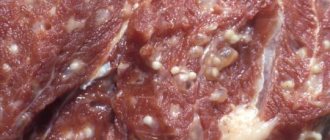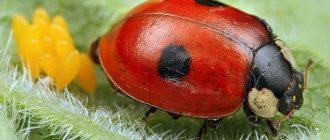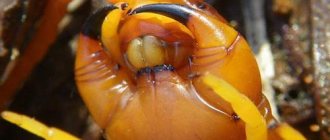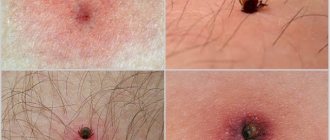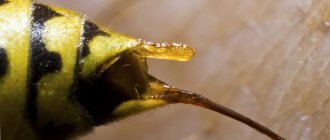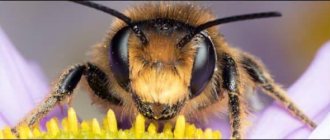Functions of the sting and characteristics of the poison
Initially, bees did not have a sting, but as a result of evolution, the ovipositor in the 11-12 segments of the abdomen turned into this organ and became an instrument for protecting honey. Only females have it, so drones do not sting. Thus, the functions of the stinger are to inject poison into the body of enemies to stop them and protect the hive. He can be attacked by:
Thanks to the stinger, worker bees can attack in case of danger and defend themselves. The poison released from it has a pleasant aroma and is a colorless liquid. This is a secret produced in 2 poisonous glands - large and small. In the bee's body it is contained in a special bag.
When studying the chemical composition of the venom, 13 amino acids and various compounds were identified, but its basis is melitin, a protein substance or peptide of bee venom. It has properties that can remove bacteria.
The functioning of the venom-producing gland depends on the age of the bee. If she has just crawled out of the cell, then the bag contains a minimal amount of poison. After a week of age, the reservoir is almost completely filled with a toxic substance. The maximum amount of poison is collected in the bag on the 15th day. When the bee becomes a “guard,” around day 19, the sac is completely filled with poison.
In bees emerging from the cell in the fall, the activity of the poison-producing gland begins much later (only on the 14th day) and ends on the 20th day.
It is worth noting that the queen bee uses the sting not only for her own protection, but also for laying eggs. This is one of the main functions of the uterus, because it must continue the birth. To strengthen oviposition, she places the sting in a perpendicular position. The queen bee has a longer length than the average bee.
Bee venom and timing of functioning of the stinging apparatus of worker bees
The bee venom flowing from the sting (a colorless liquid with a pleasant odor and an acidic reaction) is a mixture of the secretions of two glands: the large and small poisonous ones. It is in a special bag, and when stung, it enters the wound and exerts its painful effect.
The chemical composition of the poison is complex, it contains 13 amino acids and a number of other compounds. The basis of bee venom is the protein melitin. The poison has bactericidal properties.
The function of the stinging apparatus of the worker bee is related to age. From the 2nd day after its exit from the cell, a small amount of poison is detected in the reservoir of the poisonous gland.
On the 6-7th day, a noticeable replenishment of the reservoir with poison is observed, and its maximum filling occurs between the 10th and 16th days. By the time the worker bee transitions to guard duty (age 12-15 days), the activity of the poison gland ceases.
In the autumn generation of worker bees, the activity of the poison gland begins to manifest itself from the 14-15th day after leaving the cell, and ends by the 20th day.
When stung, a bee releases 0.25 mg of poison.
Where is
The sting is located at the back of the insect's abdomen and is considered a modified ovipositor. The bee's abdomen can easily bend, so it has no difficulty in inserting its sting into the victim.
In addition, it has a tip on which there are serrations that can only be seen through a microscope. They make it much more difficult to remove the sting from the offender's body.
Insect stings should be examined under a microscope; they have a special structure.
The bee's sting looks like a modified ovipositor and is located at the back of the abdominal cavity. Bees have a flexible abdominal structure that helps when striking. The insect leaves a stinger under the skin of the victim and dies.
Under a microscope, a bee's sting looks like a part of the body with serrations, with the help of which it gets under the skin of an animal or person.
The effect of bee stinger venom is long-lasting.
Under a microscope, a wasp sting appears as an elongated, pointed part, connected to the venom gland.
Features of structure and location:
- located in the back of the abdomen, translucent in color, retracted in the passive position, and appears outward in the active position;
- the gland contains a duct through which the poison moves and enters the victim;
- represented by 2 elongated stylets, from the abdomen they appear along the sled - additional formations;
- consists of smooth walls;
- the sleds are covered with plates; when bitten, they open, the sled extends, and the stylets slide.
What kind of organ is this and what are its dimensions?
A bee's sting is an organ measuring from 2 to 4.5 mm, which it inserts into the body of its offender, injecting poison, which causes pain and burning. Interestingly, the poison in the sting continues to be released even after the bite.
The sting has two parts:
- Motionless . It consists of: sled;
- sled processes;
- oblong plates;
- palps.
- triangular plate;
A bee needs a sting for defense, but it can only sting once, after which it dies. The fact is that when struck, the sting remains under the skin of the offender, and without it the bee cannot exist, since it is part of its body.
Life cycle of worker bees and their purpose
After being stung, the bee flies away from the offender with an open wound and dies.
How does a bee sting work?
The bodies of bees differ - their structure depends on the functions performed in the family, so queens, drones and workers have different anatomy. The sting can be up to 4.5 mm long. It is necessary for protection from other insects and animals. In case of danger, the bee sprays poison that causes burning and pain.
The sting, consisting of a fixed and movable section, is located on the bee's abdomen. In a calm state, it is hidden under the joint. This weapon is attached to the body and intestines with thin films for protection. The fixed section includes an unpaired middle part - a sled about 2.5 mm long, looking like a trench. Their front part widens slightly, and the back, on the contrary, narrows and ends with a sharp groove. In front of the sled, arched lateral processes diverge, between which there is a fork with sting muscles. Elongated plates are attached to the processes from above.
Bees and their structure vary depending on the duties they perform in the hive. In any case, an insect bite does not pose a threat to human health. The only exception is the presence of individual intolerance.
The movable section includes two styles - these are thin needles, at the end of which there are notches. The queen bee has 5 such notches, while the worker bee has 10. Along the entire length of the stylet there is a large longitudinal notch that extends onto the roller of the sled. Thanks to this connection of stylets and sleds, movement is carried out. The cavity formed by them is a channel through which the poison flows.
Causes of bites
Experts say that these insects sting only in the most extreme situations. And the voluntary desire of a bee to attack a person is an exception to the rule rather than a pattern. In order for her to attack, she must first be provoked to such actions.
A bee begins to attack only in those cases when it begins to think that a person may pose a danger to it and, as a result, become a source of serious problems. For example, bees bite when they become confident that a person can destroy their hive or take their honey. Based on this, one of the main attributes of a beekeeper is a protective suit.
Bees also attack when they believe that a threat is hanging over them. Therefore, if you hold an insect in your palm, it will certainly sting its offender.
But the reasons for a given insect bite are not always as obvious as in the cases described above. For her behavior to become aggressive, sometimes the following factors are sufficient:
- Strong smell. In order to provoke a bee to sting, you just need to perfume yourself with eau de toilette with a pronounced odor. In its absence, the bee may also react negatively to the strong smell of sweat.
- Color of clothes. It has been proven that people wearing dark clothes are stung by bees more often. Therefore, the practice of wearing white protective suits has long been common in beekeeping.
- The smell of smoke. It can also cause an insect attack. Bees quickly recognize impending fires that destroy their homes, so this problem is one of the most pressing for these insects. Therefore, when encountering a bee after a fire begins to flare up somewhere, the person who gets in its way runs the risk of being attacked by it.
- Bee venom. When this insect bites, other bees may appear if they smell the poison of their relative.
In addition, it is also worth paying attention to the fact that not all bees bite the same way. Insects living in different regions of Russia have different attitudes towards humans. Carpathian representatives of this class are the calmest. While Central Russians and Caucasians can behave unfriendly even for no apparent reason.
What are the benefits of bee venom?
This type of poison is used in medicine. They treat various diseases. Experts have established the antibiotic properties of bee venom, which are destructive to seventeen varieties of bacteria. It is also known that bee venom has the most powerful antimicrobial effect if it is collected during the bribe season.
Based on the fact that every life phenomenon always has two sides to the coin, bee venom can also be viewed from two different points of view. On the one hand, it can be deadly, but on the other hand, on the contrary, it can put a person on his feet.
In fact, bees are not as scary and evil as we used to think about them. Based on the stories of beekeepers and the observations of scientists, the bee uses its poisonous weapon in the form of a sting only in the most exceptional cases.
For her, this is, first of all, just a tool of self-defense, but not a tool of defense or attack. A bee can sting only if it sees the object of its attack as a threat to itself or honey collected through hard work.
There are also a number of other reasons that can ruin a bee’s mood and make it want to sting everything and everyone.
The bee has very thin and sensitive olfactory receptors, which allow them to recognize the aroma of flower nectar at a distance of up to one kilometer. That is why she simply cannot tolerate all kinds of strong and pungent odors, such as the smell of perfume or sweat.
Also, according to observations, bees prefer to sting people in black clothes; they are more loyal to white ones. The smell of smoke also irritates the insect, so we do not recommend smoking near the apiary, unless, of course, you are looking for a strong sensation.
Well, if you have already been stung by a bee, and the others smelled its poison, get ready for a second attack. The smell of their own poison is perceived by these insects as a call to action and protection of their family.
However, bees, like all women, sometimes experience some instability of mood. This is especially pronounced during periods of weather change, before heavy rains or during the season of strong winds. These days, bees can sting without any particular, visible reasons, simply because of their bad mood.
The fact that a bee stings only in extreme cases is not surprising, because along with the sting, it also loses its life. Once in the skin, the bee does not have enough strength to pull the sting back thanks to the microscopic barbs located along its entire length, so it breaks out of the insect’s abdomen along with part of the internal organs and remains in the victim’s body.
The sting that gets into the bitten person continues to live its own life and release its poison into the bite cavity. Therefore, the faster it is removed, the less poison will remain in the body, and, accordingly, the less allergic reaction to the bite will be.
You should not be too afraid of bee stings, because if you are not allergic to the poison, in moderate quantities it is even beneficial for the human body. For example, bee stinging is used in the treatment of joint diseases. This is healing through pain!
Stinging process
The sting occurs at the moment of contact with the enemy. The bag-like chamber contains the entire apparatus. A narrowed slit located in the seventh abdominal part leads to this chamber. In a calm state, it is not visible, as it is in a case. To indicate outward, muscles must act on the case, which will lift it upward.
In preparation for the sting, the abdomen lowers and bends. When attacking, it exposes part of it, as shown in the photo.
When stung, the abdomen is in one position, only downward and backward movements are made. If the sting does not occur, it retreats back into the chamber using its muscles.
Separation occurs when, after stinging, the bee wants to fly away. In this case, it begins to break out strongly. The serrations do not let him out of the body. Then it breaks away.
Remaining in the body, the onset of autonomous action occurs in the form of rapid contraction. Toxic substances are released and begin to accumulate.
More toxic substances will be released if it is not removed. If possible, you need to pull it out quickly.
The work of the sting during a wasp attack
The wasp will be able to pull the sting out of its abdomen at the moment of striking. After the attack has been carried out, the insect is ready to repeat the attack.
The main difference between a wasp and a bee is the ability of the first to pull out the sting; the bee will leave it under the skin of the victim.
The wasp is capable of inflicting 4-5 bites in a row; 0.3-0.4 mg of poison will enter the body per bite.
Difference between the sting of a worker bee and a queen bee
The worker bee's sting is a protective device. The uterus has a curved sting with 3 serrations. She freely pulls him out of the wound and can sting him several more times. The queen uses her sting only in a fight with another queen (if by chance a rival gets into the hive, they enter into a fight that ends in the death of one of them).
In exceptional cases, if the uterus is not yet fertilized, it can sting a person. The sting is not painful at all, but sometimes the area where the person's skin was pierced will feel somewhat itchy for several days.
The queen's sting is also an ovipositor, apparently, which is why she avoids using it as a weapon of defense and attack.
The fertilized human uterus never stings.
Differences from a wasp sting
A bee's sting differs from a wasp's:
- When a wasp stings, it inserts a sting into the soft body of its enemy, which is possible due to the presence of barbs. The sting has a saw-shaped stylet made of hard chitin, inside of which there are 2 lancets. The sting has a point, making it easier to insert into the body, and glands filled with poison.
- Unlike a bee, after a wasp stings, it does not die and can even sting several more times. The wasp's sting has much smaller serrations, so when they are removed back from the body, they do not cling very much. In addition, there is no knot at its tip, so the wasp can easily remove the sting.
- Individuals sting in different ways. The wasp is an aggressive insect, so it can sting or simply bite with its jaws. She doesn’t need a reason - just a wave of her hand or a scent that is unpleasant to the insect is enough. Its bite is very painful, often causing swelling and inflammation, especially if it was done by a large insect. A bee stings only when it needs to protect the hive.
- After a wasp bite, there will be no sting in the wound, but a bee sting will remain sticking out like a splinter. A bee sting is less painful than a wasp sting.
Effective protection of bees from mites
What to do if stung by a bee
The sting of one bee is not dangerous to human life, since the amount of poison injected is only 0.1-0.3 mg. But if a swarm attacks, its level can rise to 0.25 g, and this dose is considered lethal.
In addition, a lot depends on the location of the sting. It is especially difficult to tolerate on the face, lips, eyes, and neck. People die not so much from insect venom as from suffocation due to swelling of the neck or tongue.
In any case, the sting must be quickly removed from the resulting wound, since the poison will be released through it even after the bite. In this case, the person will experience burning pain. If the correct measures are not taken, swelling and hyperemia will occur at the site of the bite. In severe cases, the wound may become inflamed.
Many beekeepers who are stung frequently have little reaction to the sting as they develop temporary immunity. A person can experience 10 to 15 bee stings if they happen regularly.
Usually a person perceives a bee sting as painful. The sting torn from the bee continues to go deeper into the body of the victim, while at the same time poison is injected into the wound it creates.
The longer the sting stays in the human body, the more poison will flow into the wound. Therefore, to reduce pain, you need to pull out the sting as soon as possible in such a way as not to press on the reservoir of poison, for which you should pick off the sting to one side with your fingernail or the tip of a knife, but do not pull it out with your fingers.
The sting site should not be rubbed, otherwise the swelling may increase. The stung area must be moistened with 0.25% ammonia or 6–8% acetic acid. For severe tumors, aluminum acetate should be used. Persons susceptible to allergies should be given 50 g of alcohol.
Doctors use histamine or adrenoline injections for stings (histamine dilates blood vessels, adrenaline constricts them). People with allergies should first take an injection of calcium chloride.
In small amounts, bee venom is not harmful to most people. It is dangerous only for people with heart disease.
People usually get used to bee venom, but the immunity developed is temporary, unstable, and disappears over time. Healthy people can withstand 500 stings.
Individuals immune to bee venom, such as beekeepers who come into contact with bees every day, are not even dangerous from snake bites.
How to remove a sting at home
Bee sting - how to relieve swelling
After a bee sting, you need to remove the sting as quickly as possible. Many people try to remove it with their fingers. It is not recommended to squeeze it, especially if the affected area is sensitive. This is argued by the fact that during squeezing, the poison in the body spreads several times faster. It is best to remove the sting using tweezers or a needle. This should be done as carefully as possible, since even a slight violation of the integrity of the skin is a potential conductor for infection. Particular attention should be paid to the process of removing the sting. You need to grab it with tweezers right next to the skin, then just pull it out. It is important to capture the sting below the venom bag, otherwise all the venom in it will enter the body.
How to remove the sting
Note! After extraction, it is necessary to treat the affected area with any product that will help neutralize the poison and also get rid of itching. The best option would be to use salted water, potassium permanganate or an alcohol solution.
If one bee has bitten you, you don’t have to do anything with the sting, provided that the person is not allergic to bee venom. In this case, a person may not feel pain at all and simply forget about the sting. After a bite, a small abscess will form on the affected area, with which the sting will come out on its own.
If several bees have stung, then after removing the sting, a person should drink as much liquid as possible to remove the poison as quickly as possible. The most useful drinks in this situation are compotes, herbal teas, as well as water with honey dissolved in it. It is strictly forbidden to drink hot tea and alcoholic beverages.
On a note. Taking vitamin C can help improve the condition. After a sting, it is recommended to take an antihistamine. This will help prevent the possible development of an allergic reaction.
To relieve swelling, apply a cold compress to the affected area. It is strictly forbidden to scratch the bite site. If the itching is severe, then you should treat the affected area with an ointment whose active ingredient is hydrocortisone.
In case of increased susceptibility to bee venom, you should immediately seek medical help.
This also applies to the following situations:
- in case of a massive bee attack;
- if the bite was made in the head or neck area;
- when biting mucous membranes, mouth and eyes.
Bee sting
Help for a bite without allergy symptoms
If there is no allergy, then symptoms will appear in the form of slight swelling and itching. This suggests that the bite is not life-threatening. To provide first aid, use:
- ice or cold water;
- baking soda;
- antihistamine;
- painkiller.
Follow the following sequence of actions:
- Remove the sting as soon as possible. If it sticks out on the surface of the skin, then use a fingernail and grab it with your fingers. You should not use tweezers, as pulling may release more poison. You can’t squeeze him out!
- The resulting wound is washed under running cold water, using liquid soap to disinfect the area.
- Take antihistamines. For example:
- Cetirizine;
- Tavegil;
- Suprastin;
- Fenistil;
- Zyrtec;
- Erius.
- Treat the wound with antiallergic cream. You can apply a damp cloth soaked in a baking soda solution to this area. The solution is prepared at the rate of 1 tsp. for 1 glass of water. If you don’t have soda, you can replace it with hydrogen peroxide, a weak solution of potassium permanganate, salt water, 0.25% ammonia, 6% vinegar. Do not scratch the bite site!
- Cold is applied to the wound to relieve pain symptoms and quickly spread the poison. Cold prevents swelling. This could be ice or a towel soaked in cold water.
- For severe pain, take painkillers:
- Aspirin;
- Ibuprofen;
- Nurofen.
- Drink plenty of fluids.
How to relieve swelling after a bee sting using folk remedies?
Important: Situations when there are no medications at hand to provide first aid for insect bites happen often. Tourists, those who like to relax in nature or in the countryside should not forget about this safety rule.
But when there are no medications at hand, and a bee has bitten you, you can try to relieve the pain and also relieve swelling using folk remedies:
- Lotions with soda. Dilute a teaspoon of baking soda in 1 glass of water, soak a piece of gauze in this solution, and apply to the sore spot.
- It is recommended to drink tea or a glass of water with lemon.
- Activated charcoal and aspirin will help remove the poison. There is no need to take these tablets orally, because there is no food poisoning. You should crush the tablets and add a little water to make a paste. This mixture must be applied to the sore spot.
- Chopped parsley leaves will help relieve swelling. To do this, fresh parsley needs to be chopped and poured with boiling water. When the liquid has cooled, soak a cotton pad in the solution and apply to the swelling.
- It is not for nothing that the aloe plant received the nickname “house doctor”. It saves in many cases, and is also effective against bites of winged insects. You can apply aloe juice or a whole leaf to the swelling, with the pulp to the sore spot. Pain, redness, and swelling disappear after several applications of aloe.
- Onions contain bactericidal substances that eliminate poison components. Just a few minutes after applying the onion, the swelling decreases significantly and the redness goes away. The onion can be applied in the form of a paste, as well as a cut half. The main thing is that the juice stands out.
- Iodine mesh helps relieve swelling. It fights the inflammatory process at its initial stage.
- Olive oil. Chilled olive oil will help relieve swelling. Unsaturated fatty acids promote skin regeneration and restoration.
- Yarrow compress. The leaves of this plant can be mixed with parsley leaves, crushed into a paste and applied to the bite site.
- Fresh potato slices cool the burning pain and reduce swelling.
Folk remedies for bee stings
Help from a bite with allergies
A bee sting cannot be fatal to a person, however, if he is allergic to bee venom, then everything becomes significantly more complicated. Unfortunately, many people learn about allergies only after being stung by a bee.
Insect venom is a mixture of protein compounds. Some people react to them by developing an allergy, leading to serious consequences in the form of Quincke's edema and anaphylactic shock.
Allergy symptoms after a bite are as follows:
- severe swelling;
- pressing feeling in the chest area;
- difficulty breathing;
- the presence of red itchy spots throughout the body, urticaria;
- headache;
- weakness;
- nausea and vomiting;
- elevated temperature;
- convulsions;
- pain in the lumbar region and joints;
- loss of consciousness.
With such symptoms, you should urgently call an ambulance.
The actions carried out to provide first aid are as follows:
- Use an epinephrine pen if the victim has one. Usually, allergy sufferers always have it with them.
- Unbutton the collar and loosen the tie so that the victim can breathe easier and the clothing does not constrict.
- Lay the victim down, and then cover him and cover him with heating pads with warm water.
- Give 25 drops of Cordiamine to support the heart.
- If there is bleeding from the nose and vomiting, turn the victim onto his side.
- Lower the bite site below the level of the heart so that the poison moves slowly through the blood.
- Call emergency medical assistance immediately.
After assistance, swelling may persist for 1-5 days, and on the face for about a week.
Treatment of the consequences of a bite
If you are hypersensitive to the components of the venom, a bee sting can cause undesirable consequences: tumors or allergic reactions. In addition to allergy sufferers, children and pregnant women are also at risk. With proper treatment, you can minimize discomfort and prevent the development of complications.
Edema, swelling
Folk remedies will help relieve swelling after a bee sting: plantain, chamomile, parsley. At home, you can use a soda compress; A cold lotion based on hydrogen peroxide or ammonia will help. A compress of dissolved aspirin helps neutralize the burning sensation and swelling from a bee sting. Beekeepers advise rubbing the area that was stung by a bee with honey or garlic juice. If the swelling does not go away, antihistamines are used.
Allergy
A bee sting can cause hives or even anaphylactic shock. The body's reaction to poison is individual. Even a single bite can be fatal for allergy sufferers. There are three degrees of severity of an allergic reaction.
In mild cases:
- chills;
- increased body temperature;
- heart rhythm disturbance.
In cases of moderate severity, urticaria is added to the above symptoms. Pale pink blisters appear on the body, not necessarily at the site of the bite. Hives are accompanied by severe itching. Antihistamines are used for its treatment. It should be remembered that they cause severe drowsiness. To select the optimal drug, it is better to consult a doctor.
In severe cases, spasms and swelling of the mucous membranes are possible, which, in turn, can lead to suffocation. One of the characteristic manifestations of allergies is Quincke's edema, or acute angioedema. It is also called giant urticaria. Quincke's edema is provoked by a biologically active substance present in bee venom - histamine. As a result of local expansion of capillaries and veins, the lips, tongue, and upper respiratory tract swell, which leads to suffocation. The disease progresses instantly, with only a few minutes left to provide first aid. The victim is injected with a solution of suprastin or pipolfen intramuscularly and emergency assistance is called. Hormonal agents such as dexamethasone can be used.
The most dangerous reaction to a bee sting is anaphylactic shock. It, like Quincke's edema, develops instantly and can even lead to death. During anaphylactic shock, loss of consciousness, bronchial spasm and a sharp drop in pressure are observed. People prone to this form of allergic reaction should not spend time outdoors without having an adrenaline syringe at hand. The victim is given an injection and an ambulance is called: resuscitation measures may be required. Further treatment is carried out only in a hospital setting. Regardless of the severity of the allergic reaction, the victim should seek qualified help.
To protect yourself, it is important to know how the body reacts to bites. If the venom does not cause allergies and you are aware of what to do in case of a bee sting and how to remove the sting, the swelling and itching will go away in a few days
If an allergic reaction occurs, it is better to exclude the possibility of a bite. In any case, the bees do not attack first, because each individual that stings dies. If you do not irritate the striped workers with sharp sounds, movements or smells, they will not sting.
https://7ogorod.ru/prochee/zalo-pcely.html
https://vredinfo.ru/shershni-i-osyi/ukus-pchely-pervaya-pomoshch
How long does a bee live after being stung?
Often, the appearance of a bee causes fear in people, and they try to drive it away by waving their arms, handy objects, not realizing that they are only doing worse - they show the bees that they are aggressive, and they themselves attract attention, bees do not attack just like that, they peaceful insects, minding their own business.
The lifespan of a stung bee is very short, does not exceed 2-3 hours. There is information that the bees remained alive and worked as usual after the sting, but this fact has not been confirmed.
Folk bee signs
Why does a bee die after being stung? Everything is quite simple. Having pierced the sting into the elastic skin of a person and sprayed out the poison, the insect will actively try to get it back. But he won't succeed.
The sting is firmly stuck in the victim's body, and can only be pulled out with tweezers or other means. Along with the sting, poisonous glands and part of the intestine remain in the person, since the wound is quite extensive, the bee has practically no chance of survival.
Interesting fact. Bees will never bite if their abdomen is sufficiently filled with honey. In addition, the queen will not sting, even if you mock her - she uses her sting only when meeting with a rival.
All life spans of these insects are quite arbitrary. To ensure the long life of your apiary, first of all, you need to properly care for the bees and create all the necessary conditions.
Once a bee stings, it can only live for a few hours. When it bites a person, it dies due to the fact that it is impossible to pull the sting back out of the elastic skin. When a bee stings an insect that has a hard chitinous layer, it can pull the stinger back, so it remains alive.
If a bee is stung by another insect, it dies immediately.
How is bee venom formed?
Bee venom is a colorless liquid with an odor reminiscent of honey. It is a biologically active substance, so it dries instantly in the open air. In large quantities it is an extremely harmful and even dangerous substance for humans (the sting of 450 bees is considered fatal, 180 or more causes severe poisoning). In small doses, bee venom is used in cosmetology and medicine.
The venom is produced in the sting gland of bees. Both worker bees and queen bees have such glands - they secrete exactly the same poison. Each bee's sting contains from 0.2 to 0.8 milligrams of poison, which the insect injects when biting. For worker bees, poison serves as a means of defense for the hive and colony. The queen uses her sting solely to eliminate her rival.
A bee's sting is designed in such a way that once it has pierced the skin, it cannot pull it back out. Contrary to popular belief, not all bees die after being stung. If the insect carefully flies away from the victim, it will remain without a sting, but will survive. Death occurs not from the loss of the sting, but from damage to internal organs when it is removed from the bee’s body, when the insect is in a hurry to move away from the victim.
Prevention from a bite
People with allergies to bee venom should exercise increased caution. It would be a good idea to take the following precautions:
- Wear a protective suit or closed clothing with long sleeves. Although insects can sting through fabric, in some cases it can still provide protection.
- Do not wear perfume or wear bright clothes both when working in the apiary and when going out into nature. It attracts insects.
- Do not go close to the nests of wasps and wild bees, or the apiary without a protective suit.
- When walking, you should pay attention to the presence of large concentrations of stinging insects. It is better to leave such places in time.
- If there are such nests at your dacha, it is better to call specialists and get rid of them.
Bees are peaceful insects that sting only in exceptional cases. It is better to avoid large concentrations of them, be careful and not provoke them. In case of a bite, first aid must be provided and doctors must be called.
What to do if you are bitten
- Get rid of the poison using a regular clean needle.
- Mix alcohol with water and soak cotton wool in this mixture. It needs to be applied to the affected area.
- Salt water and manganese work well.
- To remove the sting, some people use cut potatoes.
If a person is bitten by one bee, and he is not allergic to the poison, if the sting that is left at the site of the bite is not pulled out, no terrible harm will be caused. A small abscess will appear at the site of the bite, which is visible in the photo, and everything will come out of the wound on its own.
So, let’s summarize and look again at the action and structure:
- The difference is in the sawtooth shape. This difference can be seen under a microscope.
- When biting, the weapon remains at the site of the bite
- Contraction and release of poison occurs.
- When mammals attack a colony of bees, they die completely. If some manage to survive, they will still die. Their lineage will not last on its own.
- Can attack any animal and person.
Author: Barantseva Oksana

